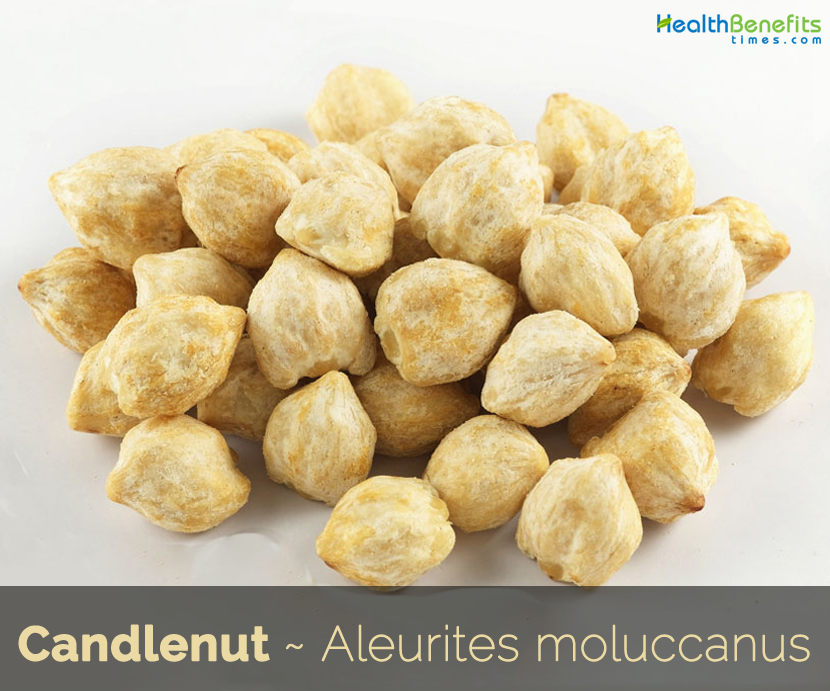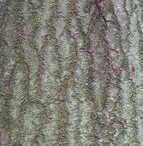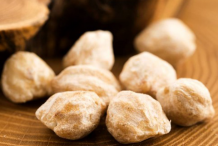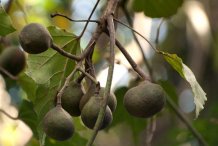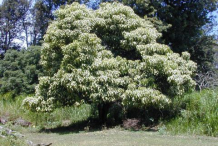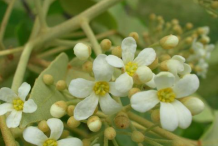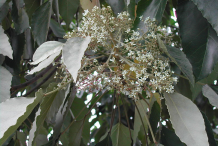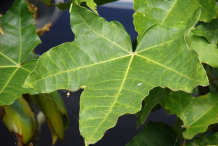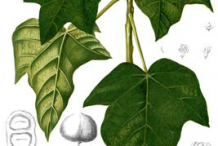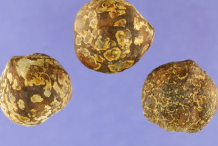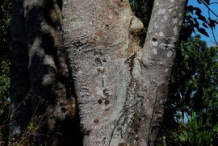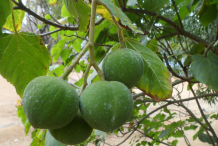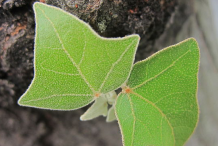Plant Description
Candlenut is a medium sized, perennial, evergreen, upper-canopy tree that grows about 10–47 m tall. The plant thrives best in a warm, humid tropical environment. It is common in wet secondary forest at the margins or along stream and along the seashore. It will also thrive in a semi dry to wet subtropical forest climate and in areas. Candlenut trees grow on a wide variety of soils which includes acidic soils, sandy soils, red loamy soils, limestone and stony clay soils. They are not fond of alkaline soils. However, they can tolerate soils which are neutral to slightly alkaline. The soil should be moist and well drained. These trees also have a good tolerance for infertile soils. The plant has straight and cylindrical bole and can be up to 70 – 150 cm in diameter. Bark is grey-brown to blackish colored.
Leaves
The leaves are very distinctively shaped but also quite variable in gross morphology. Young leaves and leaves on lower branches are often three-lobed or five-lobed, while older leaves and those on higher branches tend to be a simpler triangular or oval shape. They are typically 10–20cm long with wavy margins, and are arranged alternately. Where the leaf stalk joins the blade of the leaf, there are a pair of glands that produce a sweet secretion. The petioles are almost 30 centimeters in length. The leaves have a pale green coloration.
Flowers
The inflorescence is around 10 to 20 centimeters in length. They have an upper axillary or terminal and thyrsoid arrangement. The unisexual flowers are white in color. The female flowers are found on the ultimate branchlets of cymes. The smaller male flowers are arranged all around the female flowers in groups. The sepal is comprised of 2 or 3 lobes at the anthesis. The male flowers are comprised of 5 lance-shaped petals around 6 to 7 mm in length and almost 10 to 20 stamens. The petals are larger in the female flowers, around 9 or 10 mm.
Nuts
Fruit is a round nut that is 4 to 6 centimeters in diameter. They have a hard shell covering which is green or brown in color. Inside the hard shell there is the whitish flesh or pulp. Single nuts grow on stout stalks. The nuts contain one or two seeds.
Seeds
The soft, elliptical, cream-colored seeds are found inside the nut. The seed coats covering the seeds are very hard. The length of each seeds is around 2.5 centimeters. The seeds are filled with rich contents of inflammable oil that enables the seeds to burn as candles. The seed shells are white in color which turns black as they mature.
History
The tree is probably native to a vast region from India, Sri Lanka, and Southeast Asia to northern Australia. The exact origin of this tree is unknown because of its early spread by humans. The plant is often cultivated throughout tropical Asia and Oceania as an ornamental plant.
Health benefits of Candle nuts
Candle nut tree has both medicinal as well as edible uses. They are quite popular due to their culinary uses. The high oil content in the nuts makes them suitable for edible uses. It is generally used to thicken Asian dishes. The oils may also be used as lamp oil to be used as a source of light. Listed below are few of the health benefits of candle nuts
1. Improved Digestive System
Candlenuts are excellent sources of fiber, and that’s why their inclusion in the diet can be very beneficial for the GI tract. Regular use of these tree nuts can help facilitate the digestive process. Consuming them on a regular basis also helps promote regular bowel movement because the oils they contain serve as mild laxatives.
Traditional healers recommend candlenuts to individuals who are suffering from diarrhea because its fiber content can help in adding bulk to stools, therefore putting an end to diarrhea. Candlenuts also have antimicrobial properties, and it’s no secret that most cases of diarrhea are due to the ingestion of contaminated food and water. By the way, another traditional use of candlenuts is for the treatment of dysentery.
2. Relieve of Fungal Infections
Fungal infections maybe not dangerous, but it will make sufferers uncomfortable and not confident. To relieve about it, you need put the candlenut’s oil to the part of your body with fungal infections. Do it regularly to make the results optimal.
3. Reduced Heart Disease Risk
Candlenuts are very beneficial for people whose cholesterol levels are outside of the normal and healthy range because these tree nuts help increase the levels of good cholesterol (HDL or high-density lipoprotein) and in the process lowering the levels of bad cholesterol (LDL or low-density lipoprotein).
One of the many nutrients in candlenuts is potassium, which is well-known for its ability to lower high blood pressure. The way potassium works is this: it causes the relaxation of the walls of the blood vessels, allowing the blood to flow more freely throughout your system. This helps save the heart from being overworked and becoming large.
4. Overcome Insomnia
Insomnia is some kind of sickness that makes you not sleep well. It is caused by depression, a lot of thinking, a fear of something. But with candlenut, you can overcome it. Because candlenut has melatonin that will make you relax and quick fall asleep. This is good for people with bad insomnia.
5. Treat Sprue
Sap in bark can benefits in health as treat of sprue. One thing that you need is sap from the bark of candlenut’s tree. To get the sap, you need to do this: ripped off the skin of bark and wait until the sap has shown up. After the sap has shown up, put it with cotton and gives some coconut milk. Now you have a herbal treat of sprue. Apply it on the part of your mouth that has sprue.
6. Unleash the Constipation
Constipation is always happen when someone usually less eats fibrous food. But don’t worry. One of the candlenut benefits is to solve about it. Take 1 piece of candlenut, 2 onions, 5 grams of pulasari, 10 grams of cinnamon, 30 grams of urang-aring leaves, half a teaspoon of salt, half a teaspoon of fennel, 800 cc of water. Blend all the ingredients (without 800 cc of water) until smooth. Second, boil all the ingredients with 800 cc of water. Boil it until volume at least 400 cc. Filter it and put it in the glass. Drink it twice a day, and drink as much as 200 cc per once drink.
7. Medicine Fever in Children
If your child gets a fever, take 15 grams of pulutan’s root, and some candlenut’s oil, it can down fever. What you needs are 15 grams of pulutan’s root, some candlenut’s oil, pan, some water, and a glass. First, boil all the ingredients, 15 grams of pulutan’s root and some candlenut’s oil, with waters. After that, filter it and put in a glass. And ready to drink.
8. Healthier Joints and Stronger Bones
Regular consumption of candlenuts helps save the joints from becoming achy and swollen due to regular wear and tear. Including candlenuts in the diet more often is also good for keeping the bones strong. According to nutrition experts, phosphorous, which can be found in candlenuts, is also vital for it.
9. Treat Tooth Ache
Candlenut’s sap helps to treat tooth ache too. Just like before, you need the stem from the bark. First is ripped off the skin of bark and wait until the sap has shown up. After the sap has shown up, put the sap with cotton. Apply it on the tooth which have tooth ache. Let it on the tooth until 10 minutes. After it, replace with the new one.
10. Bigger Muscles and Reduced Weight
Candlenuts contain heavy amounts of protein. It’s exactly for this reason why consuming them can help in building muscles.
Candlenuts are certainly ideal for people who are trying to lose weight due to the muscle-building protein that these tree nuts have — the bigger the muscles, the faster the metabolism. Additionally, protein is something that causes the body to burn lots of calories as it can be extra challenging for the GI tract to have it digested.
11. Heals Insect bites
Itchy insect bites can be cured by candlenut. Take 2 pieces of candlenut and turmeric with size as big as pinkie fingers. Tools in use are baker, mortar and pestle. First, bake the ingredients. After that, mashed it up until smooth. Then put it on the part of your body that was itchy caused by insects bite.
Traditional uses and benefits of Candlenuts
- Candlenut has been extensively used in folk medicine for the treatment of ulcers, headache, fevers, diarrhea and hypercholesterolemia.
- Kernel has been used as a laxative and in poultices for headache, fevers, ulcers, swollen joints and constipation in traditional medicine in south and Southeast Asia.
- Pulverized kernels, burnt with charcoal, were applied around the navel for costiveness in Sumatra.
- It is used for stomach-ache in Celebes.
- Pulverized kernel was use as poultices for headache, fevers, ulcers and swollen joints in Malaysia.
- Bark has been used for dysentery and decoction of leaves for treating scrophulosis and boiled leaves used externally for headache and gonorrhea.
- Bark was used as a remedy for dysentery (diarrhea with blood) in Java.
- Bark has been used on tumors in Japan.
- Flowers and the sap at the top of the husk were used to treat oral candidiasis in children in Hawaii.
- Reported candlenut oil uses include as a mild purgative, as embrocation for sciatica and treatment against hair loss.
- Javanese used the oil to stimulate hair growth.
- Candle nut oil has also been used as a remedy for worms and piles.
- Oil has a mild aperient action like castor oil.
- Oil has been used as a dressing for ulcers in India.
- Seeds were also used as a mild purgative in the Philippines.
- Seeds are applied externally to the male genitals as a contraceptive in Papua New Guinea.
- Leaves are used to treat constipation and food poisoning.
- Decoction of the leaves is used in treating coughs, diarrhea, pains in the chest and hernia.
- An infusion of the leaves is used as a lotion or is ingested for mouth infections of infants.
- Boiled leaves are used as a poultice to treat headaches and gonorrhea.
Culinary Uses
- Candle nut is an important spice in Indonesian and Malaysian cuisine.
- Kernels are eaten when thoroughly dry or after roasting to destroy mild toxins.
- Kernels are commonly used in curries; nut is also roasted and eaten as a snack or added to desserts, cakes, and pies.
- It is used to make a thick spicy sauce that is eaten with rice and vegetables in Java.
- Residual oil cake is processed into a snack food called ‘ dage kemiri’ in Indonesia.
- Roasted kernels are mixed into a paste with salt, seaweed or chilli pepper to make the condiment inamona, a key ingredient in traditional Hawaiian pokes in Hawaii.
Plant Parts Used
Almost all parts of the candlenut tree are useful for human use. Oil in candlenuts can be used to burn them like candles. The candlenut can also be used to prepare sweet scented oils that are particularly useful for the skin. The flowers, shells and leaves of the tree are used to make garlands. In Java, a thick satay sauce is prepared from the candlenuts that are eaten with rice and vegetables. The tree bark can be used to make a red brown dye as well.
Other Facts
- Pacific Islanders, namely Fijians, Hawaiians, Tahitians and others have been reported to use the acrid juice of the fruit wall and charred nuts for tattooing.
- Tongan used pulverized kernels in a paste as soap and shampoo.
- Nuts have been used as toys such as marbles and tops.
- Crushed kernels have been used mixed with other ingredients as fish bait.
- The shells, which can be polished to a high luster, are fashioned into earrings and other costume jewelry.
- The shells of the nuts, flowers and leaves have been used for leis in Hawaii.
- Nut in association with an iron nail and cockle shells have been used in social ceremonies when the new rice was dried in Malaysia.
- Candle nut, leaves of Bryophyllum , cockle shells and iron nail were put into water for bathing an infant suffering from fever in Malaysia.
- Candlenut oil has been used for various purposes, such as for the preparation of paints, varnishes, wood polish and linoleum, for illumination, soap manufacture, cosmetics and wood preservation, preservation of fishing nets and in the batik industry.
- Candlenut oil used in combination with coconut oil has been used for skin and hair treatment.
- After removal of the oil, the remaining seed cake has been used for cattle fodder and as fertilizers.
- Roots provide a red dye for tapa cloth, kapa and aho cordage in Polynesia.
- Wood is also made into light furniture, small boats, canoes, small utensils, fuel-wood and matches and is also suitable for paper pulp.
- Candlenut oil is used to make massage oil for a certain kind of headache (possibly caused by meningitis) in Cook Islands and Tahiti.
- Flowers, shells and leaves of these trees are used to make garlands.
- Red-brown dye is manufactured from the bark and used in kapa and aho.
- A coating of candlenut oil is applied on the fishing nets to preserve them.
- Candlenut tree wood is used for making canoes, gunwales and seats.
- Candlenuts are also used in the funerary rituals of Tonga.
- Candlenut is used for making several sweet scented oils which can be applied to the skin.
- Agrionome fairmairei larvae eat the dead wood of these trees.
- Candlenut oil is used to make a type of varnish.
- Candlenut tree is considered to be a symbol for enlightenment, protection and peace in hawaii.
- On May 1st, 1959, Candlenut was declared as the state tree of Hawaii due to its numerous uses.
Precautions
- Raw candlenuts can be toxic as they contain saponins and phorbol.
- Fresh seed contains a principle resembling croton oil and should not be eaten.
- Nut should not be eaten raw as the toxin in the oil can induce nausea and vomiting.
References:
https://www.itis.gov/servlet/SingleRpt/SingleRpt?search_topic=TSN&search_value=845627#null
https://davesgarden.com/guides/pf/go/61031/
http://www.hear.org/pier/species/aleurites_moluccana.htm
https://npgsweb.ars-grin.gov/gringlobal/taxonomydetail.aspx?id=2191
https://www.pfaf.org/USER/Plant.aspx?LatinName=Aleurites+moluccanus
https://www.cabi.org/isc/datasheet/4124
http://www.theplantlist.org/tpl/record/kew-5934
https://plants.usda.gov/core/profile?symbol=ALMO
https://en.wikipedia.org/wiki/Aleurites_moluccanus
Comments
| Candlenut Quick Facts | |
|---|---|
| Name: | Candlenut |
| Scientific Name: | Aleurites moluccanus |
| Origin | Indo-Malaysia region |
| Colors | Green or brown |
| Shapes | Fleshy, indehiscent, round to ovoid berry, 30–40 mm long |
| Flesh colors | Whitish |
| Taste | Bitter, astringent |
| Health benefits | Improved Digestive System, Healthier Joints and Stronger Bones, Treat Tooth Ache, Relieve of Fungal Infections, Unleash the Constipation, Reduced Heart Disease Risk, Medicine Fever in Children, Overcome Insomnia, Bigger Muscles and Reduced Weight, Treat Sprue, Heals Insect bites |
| Name | Candlenut |
|---|---|
| Scientific Name | Aleurites moluccanus |
| Native | Indo-Malaysia region |
| Common Names | Indian walnut, Candleberry, Candlenut, Candlenut-tree, Kukui, Lumbangtree, Varnishtree, Bankul nut tree, Indonesian walnut, Kukui nut, Moluccan oil tree, Tallow tree, Buah Keras, Tung-nut, Otaheite walnut, Balucanat, Belgaum walnut |
| Name in Other Languages | Arabic : Khasife-Hindi, Jouzebarri Australia : Tiairi, Tiairi Borneo : Bunsangil, Buah Keras, Kameri, Kami, Kemiri, Kemiting; Brazil : Nogueira-Da-I´Ndia, nogueira-de-igape; noz-da-índia; saboneteira Carolinian : Raguar Creole : Lèrit, Nwa, Nwazèt Chamorro : Lumbang, Raguar Chinese : Shi Li (石栗), He shi li (和石栗), Cook Islands : Tuitui, Tuti Cuba: Arbol de la luz, nogal prieto; nogel de jardín Czech : Tungovník Molucký Danish: Bankultrae Dutch: Bankoelnoot, Kemirinoot Eastonian : Moluki Tungpuu English: Indian walnut, Candleberry, Candlenut, Candlenut-tree, Kukui, Lumbangtree, Varnishtree, Bankul nut tree, Indonesian walnut, Kukui nut, Moluccan oil tree, Tallow tree, Buah Keras, Tung-nut, Otaheite walnut Fijian : Balucanat, Kubui, Lauci, Lauthe, Lauthi, Nggerenggere, Qereqere, Sikeci, Sikeli, Sikethi, Toto, Tuitui, Tutui, Waiwai Finnish: Hopeatungpuu French : Nois Des Indes, Noix De Bancoul, Noix De Moluques, Noyer De Bancoul, Noyer Des Moluques, Bancoulier, Aleurites, Noisette, Noix, Noyer, Noyer Des Indes, Noisette des Grands Fonds French Polynesia : Tahii, Tahiri, Tiairi, Ti‘A‘Iri, Tutui Futuna : Tutui German : Kerzennussbaum, Lichtnussbaum, Candlenuß Greece/Crete: Lerit Guam : Lumbang Hawaiian : Kukui, Kuikui Hindi: Akhrot, Akola, Akrot, Jangli Akrot, Jangli- Akhrot (ज॓गली अखरोट) Indonesia: Anoi, berau, bontalo dudulaa, boyau, buwa kare, kamere, kamiri, kembiri, kemili, kemiling, keminting, kemiri, kemwiri, kereh, komere, kumiri, lana, madang ijo, mi, midi, miri, muncang, nena, nyenga, pidekan, saketa, tanoan, tenu, wiau Indonesia/Sumatra : Kemiri, Miri, Muncang Italian: Aleurite delle Molucche, Noce delle Molucche, Noce di bankul Japanese: Kukui nattsu (ククイナッツ), Kukui noki (ククイノキ), sekiriteu Kannada: Akroda, Arkod, Akrotu, Jaiphala, Naadu Akrotu, Naati Akrotu, Natakrodu, Naadu Aakrotu, Natuakrodu Laos : Kok Namz Man Makatea : Tutui Malayalam: Akrottu, Akshotam, Karankolam, Vadam Marathi: Akhod, Akrut, Japhala, Ramakrot, Ranakot Malaysia : Buah Keras, Kemiri, Kembiri Mangareva : Rama Maori (Cook Islands): Tuitui Marquesan : Ama, Ama Micronesia, Federated states of: Raguar, sakan, shakan New Caledonia : Tai Niuean : Tuitui Oriya: Akshota Palaun : Sakan Papua New Guinea : Tutui, Kemiri, Kurup Persian : Girdagane-Hindi, Chahar-Maghze-Hindi Philippines : Biau, Rumbang, Biau, Kami, Kalumban, Kapili, Lumbang, Lumbang-Bato Pohnpeian : Sakan, Shakan Polish : Tung Portuguese : Calumbàn, Noz Da India, Nogueira de Iguape, Noz-molucana, nogueira-brasileira, nogueira-da-Índia Puerto Rico: nogal; nuez de la India; palo de nuez Rapan : Tiairi Rimatara : Tutui Rurutu : Tutui Samoan : Lama Sanskrit: Akharota, Akhota, Akshota, Asphotaka, Gudashaya, Kandarala, Karparala, Kaureshta, Madanabhaphala, Parvatiya, Phalasneha, Pritakchhada, Rekhaphala, Svadumajja, Vrittaphala Society Island : Tutu‘I, Ti‘A‘Iri Spanish : Arbol Llorón, Avellano, Avellano Criollo, Calumbán, Camirio, Lumbán, Nogal De La India, Nuez, Nuez de bancul, Nuez de candelas, Arbol de la cera Sundanese: Moentjang Swahili: Mkaa Swedish: Lumbangträ Tamil: Katakrote, Nattakkarottu, Nattkkarotu, Nattu Akrottu, Woodooga Telegu: Naattakrotu, Natakrotu, Natu Akrotu, Uduga Tagalog: Kalumban, Kapili, Lumbang, Lumbang-bato. Tahitian : Ahama, ‘Ama, Tahii Tairi, Tahiri, Ti‘A‘Iri, Tiairi, Tuitui, Tutui Thai : Photisat (โพธิสัตว์), Kue-Ra, Purat (ปูรัด), Mayao ( มะเยา) Tongan : Tuitui Tubuai : Tutui Uvea : Tutui Vanuatu : Kandel, Kandeltri Vietnamese : Lai, cây lai Visayan: Biau, Rumbang Wallis and Futuna Islands: Tuitui |
| Plant Growth Habit | Medium sized, perennial, evergreen, upper-canopy tree |
| Growing Climates | Thrives best in a warm, humid tropical environment. It is common in wet secondary forest at the margins or along stream and along the seashore. |
| Soil | Grow on a wide variety of soils which includes acidic soils, sandy soils, red loamy soils, limestone and stony clay soils. They are not fond of alkaline soils. However, they can tolerate soils which are neutral to slightly alkaline. |
| Plant Size | 10–47 m tall |
| Bark | Grey-brown to blackish bark |
| Trunk | Straight and cylindrical bole and can be up to 70 – 150 cm in diameter |
| Leaf | Arranged alternately in a spiral along the stem and branches. Leaves are green above and paler green on the underside, simple, entire, pubescent, petiolate, ovate-oblong or deltoid or shallowly 3-lobed, 24 cm long by 12 cm wide |
| Flower | Male and female parts occurring in separate flowers on the same tree. Flowers are pale yellow or greenish white, 5–10 mm long and 5–8 mm across with distinct sepal whorl and pubescent elliptic-spathulate petals, |
| Fruit Shape & Size | Fleshy, indehiscent, round to ovoid berry, 30–40 mm long |
| Fruit Color | Green or brown |
| Flesh Color | Whitish flesh |
| Seed | Hard, ridged, woody-shelled or stony-shelled, sub-globose seed, 2.5 cm diameter |
| Taste | Bitter, astringent |
| Plant Parts Used | Whole plant, kernels, leaves |
| Health Benefits |
|


